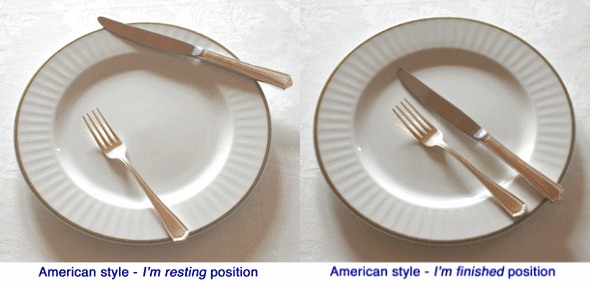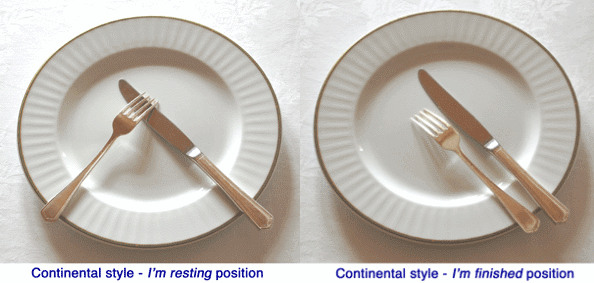Knowing how to manipulate your knife and fork with assurance is an important part of table etiquette. It's difficult to get through a meal or close a deal if you don't know where to place your knife and fork during a meal, or worse, when you've finished eating!
When it comes to dining in North America, there are two styles of eating: American and Continental. Both styles of dining are correct. The trick is to be comfortable with your choice. The golden rule for both styles of eating is whichever style you choose, be consistent; avoid switching back and forth between courses.
The American Style of Eating
Americans and Canadians are probably the only people in the world who use this style, sometimes known as "the zigzag method." It's done by holding the knife in the right hand (unless you're a leftie like me, in which case the opposite is done) and the fork in the left hand. After the knife is used to cut the food while the food is held by the fork, the knife is placed near the top of the plate, blade facing in. The fork is then switched to the right hand and used to pick up the piece of food, tines up. When you pause during eating but have not finished, the utensils are placed in the "resting position" with the knife placed on the right side of the plate in the 4 o'clock position, blade in, and the fork placed on the left side in the 8 o'clock position, tines up. This alerts your waiter that you're not finished. When you've finished eating, the knife and fork are placed side by side on the right side of the plate in the 4 o'clock position, with the fork on the inside, tines up, and the knife on the outside, blade in. This "I am finished" position non-verbally alerts the wait staff to clear your plate. Even though it's obvious you are finished eating, a well-trained waiter may ask, "Are you finished?" Smile and say yes, thank you.
Photos courtesy of Image Resource Group
The Continental Style of Eating
In the early nineteenth century, Europeans ate just as we do now, but around 1850, the upper class stopped shifting their forks back and forth, and the Continental (or European) style of eating became fashionable. A French etiquette book of the time remarks: "If you wish to eat in the latest mode favored by fashionable people, you will not change your fork to your right hand after you have cut your meat, but raise it to your mouth in your left hand."
The Continental style is thought to be a more graceful way of eating, but it does take practice. The fork stays in the left hand, with the tines pointed down, and the knife is held by the right hand. The food is then speared by the fork and conveyed to the mouth.
In between bites ("resting position"), the knife and fork are crossed in the center of the plate, fork tines pointed down. The "I am finished" position is the same as in the American style with one exception: the knife and fork are placed side by side on the right side of the plate at the 4 o'clock position, with the fork on the inside, but the tines are down (versus up), and the knife on the outside, blade in. 
Photos courtesy of Image Resource Group
Table Etiquette for Both Styles
Once you begin the meal, your utensils should never touch the table, as no one enjoys the site of a soiled tablecloth. It's improper to even allow the handle of a utensil to touch the table while the other end rests on the plate.
When a course is complete, place any utensils meant for that course on the plate, whether or not they were used. For example, if during the salad course you don't use your knife, it still goes on the plate at the end of the course. If you don't put it on the plate, the waiter will do it for you.
Lisa Mirza Grotts is a recognized etiquette expert and the author of A Traveler's Passport to Etiquette. She is a former director of protocol for the City & County of San Francisco and the founder of The AML Group (www.AMLGroup.com), certified etiquette and protocol consultants. Her clients range from Cornell University and Microsoft to Nordstrom and KPMG. She has been quoted by The Sunday Times, InStyle Magazine, the San Francisco Chronicle, the Los Angeles Times, and USA Today. She has appeared on various radio and television stations, such as ABC, CBS, and Fox News. To learn more about Lisa, follow her on www.Twitter.com/LisaGrotts and www.Facebook.com/LisaGrotts.
Photos courtesy of Image Resource Group